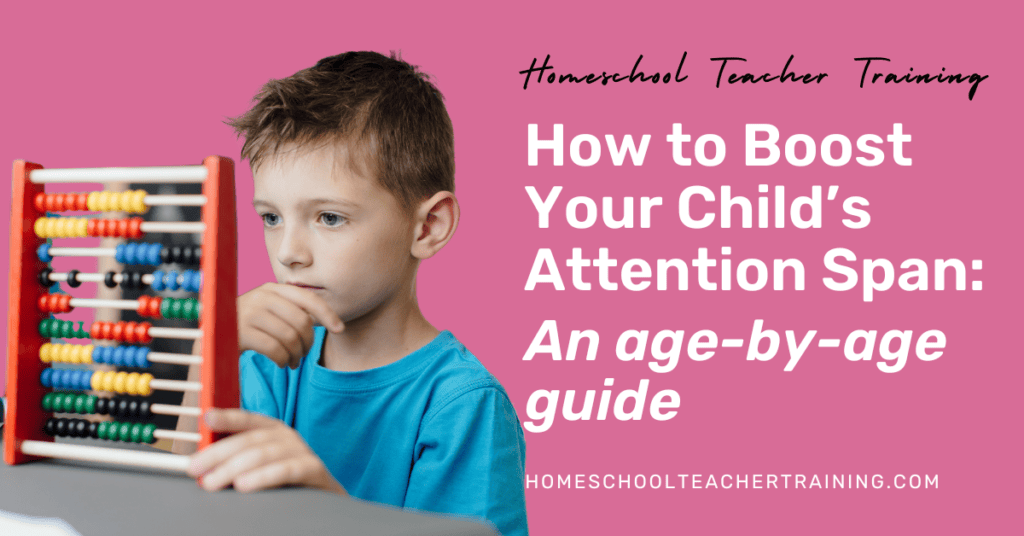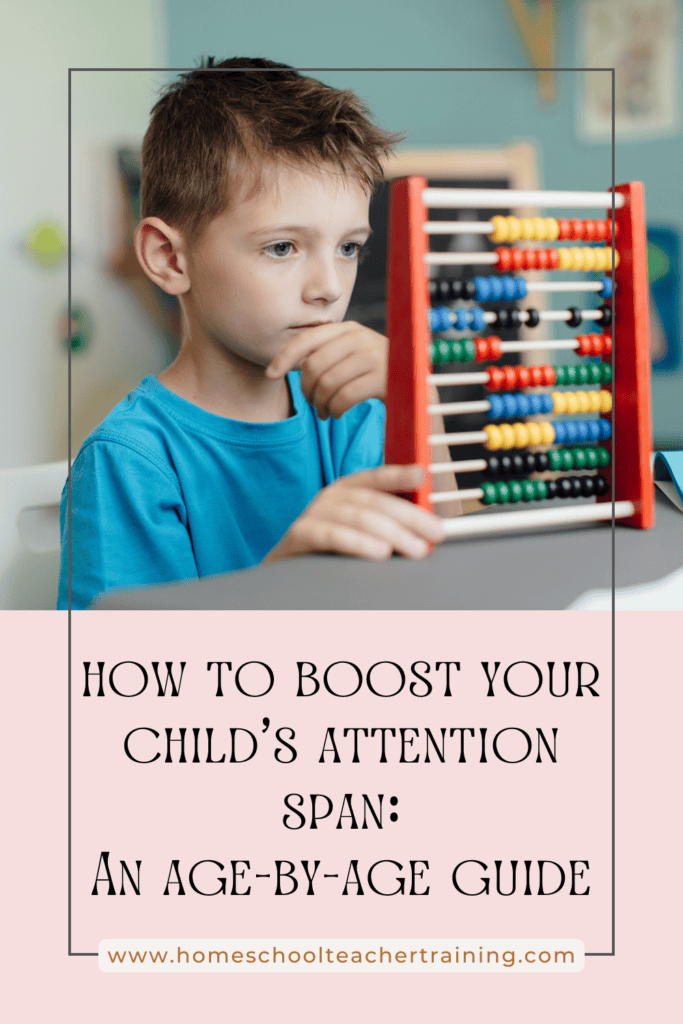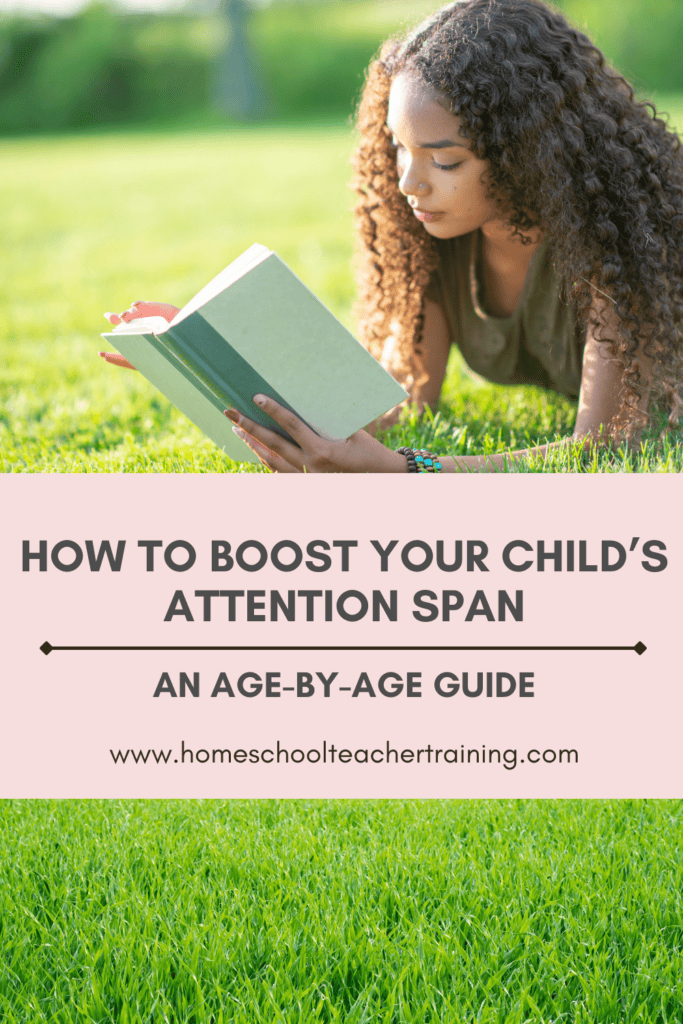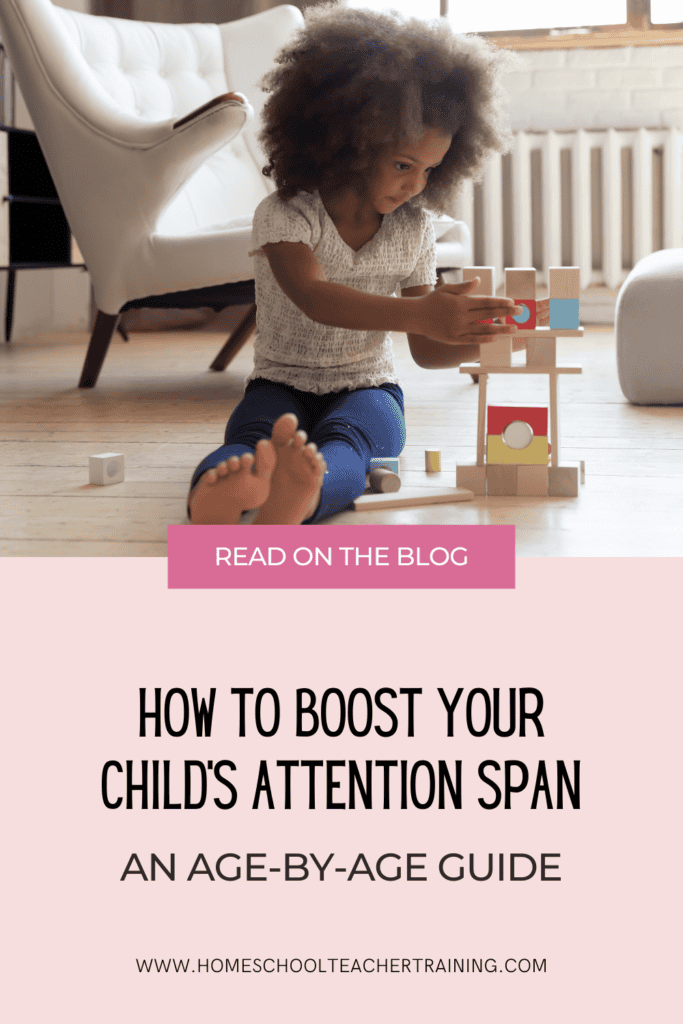How to Increase Your Child’s Attention Span: An Age By Age Guide
One of the most important things that a good academic education can do for our children is teach them the skill–and value–of directing their attention. It’s a benefit that works both ways, since their efforts to focus on school work can help strengthen their attention spans, and an improved ability to concentrate will make their learning more effective. Important lifelong skills like problem solving, perseverance, and self-direction, all involve the ability to focus on one task for a period of time.
As the attention span grows, so does the potential for deeper learning and mastery of a chosen skill or subject. You can learn how to increase your child’s attention span at any age.
Attention means “The ability or power to keep the mind on something; the ability to concentrate” (Dictionary.com). Like any ability, it needs to be practiced and supported. Many educators and child development experts have become concerned that too much screen use at a young age is shortening our attention spans.
Personally, I think there are so many benefits of using screens that I don’t think we need to take them away or even overly limit their use (I’ll write more about this in another article soon!). But I do think there are things we can do as parents and homeschoolers to help our children develop more control over their power of attention, even in a world full of screens and other distractions.
In this article, I’ll give some tips for homeschoolers about how to support our children in developing longer attention spans at four different stages of growth: preschool, elementary school, middle school, and high school. Some of these ideas are drawn from the Montessori method, and some from my own experiences or other things I’ve read over the years. Our kids need all the help we can give them to learn to navigate our increasingly complex and distraction-filled world!
Let me know what you think of these tips in the comments at the bottom of the post, and be sure to add your own so other homeschool parents can read them.

Table of Contents
Toddlers & Preschoolers: Respecting & Protecting Natural Focus
Don’t interrupt!
If you sit in a room with a small child for a while, without interacting or interrupting, you’ll see that they are naturally drawn to activities that require focus. I’ve seen one-year-olds spend half an hour or more moving blocks, one at a time, from one basket to another and back again. At certain stages they can become fully absorbed in the process of putting on a sock or buttoning a button. It’s clear that, from birth, children love to concentrate on a task that they can’t quite complete, and they feel so proud of themselves when they finally get it!
These activities are important for many reasons, but one thing they are doing is exercising their power of attention. One of the best things you can do to help at this stage is to simply not do anything! Don’t try to help. Don’t tell them they’re doing a great job. Don’t tell them it’s time for lunch. By observing quietly until they are finished, we send the message that what they are doing is important and to be respected. This helps build their ability to focus on chosen activities and their sense that they can deal with the world by paying attention, thinking, and trying things out.
Create an environment that supports focus
Young children aren’t yet ready to direct their attention on purpose. They can focus on an activity that catches their interest only so long as they aren’t interrupted or distracted by something else. We can help support them in developing their attention at this stage by making sure their environment has just the right level of stimulation.
We need to keep enough interesting toys and activities on hand that our kids can find something to do that provide a bit of a challenge and engage their attention, but not so many that they become overwhelmed. You know the feeling when you have so many things to do that as soon as you start doing one, another comes to mind and you want to start doing that instead? That’s overwhelm. It’s not fun for adults and it’s not fun for children, either. It’s certainly not an experience that will help them build their attention muscles.
It’s good to have a few times in a regular day when not too much is going on. Spend an hour or two after breakfast or lunch in the same room. You can read a book or get some work done while they play. Working times like this into your routine helps create an environment that supports focus and attention.
Provide activities that build attention
There is an important concept in educational theory called the “Zone of Proximal Development.” This describes activities that are just outside of the child’s current abilities, but that they are capable of doing if they are shown how and given a chance to practice.
Activities that are in this zone are engaging to children because they are at just the right developmental level. They are difficult enough to require some concentration, but not so difficult that it’s impossible for them to do. With a little persistence, and maybe a little help from a parent or sibling, the child can accomplish the task and feel satisfied.
Finding activities that are in the zone of proximal development for your child is a great way to support them in developing their powers of attention at any age. For toddlers and preschoolers, look for new games, toys, and other activities that are at just the right level for them. Your child will let you know whether something is a good fit by becoming engaged rather than bored (if it’s too easy) or discouraged (if it’s too hard).
Elementary Grades: Learning How to Pay Attention in School
Learning how to learn
Somewhere around four to six years of age, children start to become capable of exercising more direction over their attention. At this stage, we can begin to incorporate short periods of schoolwork into our routine and they can begin to learn how to pay attention in school.
The most important lesson in kindergarten and early elementary is “learning how to learn”. This is especially true for homeschoolers. Children who go to traditional school have daily rituals and a change in location to signal to them that it’s time to learn; when we do school at home, we don’t have the same structure. We need to purposefully change our child’s routine from total free play to, eventually, spending a few hours a day on studies. This change takes time. Fortunately, we can take more time, because learning at home one-on-one is more efficient.
Remember that your young children must learn how to direct their attention before they can learn from books or lessons. School work requires a different mode of learning than they are used to, and we have to lead them into the new expectations. Keep lessons very short. You can even spread them throughout the day — maybe doing a little math after breakfast and a little reading after lunch. Lengthen learning periods slowly and gently as your child demonstrates the ability to stay focused for longer.
There is no rush; if you stay consistent they will learn everything they need to learn before they grow up without pushing them beyond what they are able to do today.
Don’t overschedule
Children need time to be calm and at ease in order to get into a state of focused attention. When children are overscheduled and oversupervised, the result is often heightened anxiety, as Jonathan Haidt explains in his book, The Anxious Generation (not an affiliate link). An anxious child is always on the lookout for the next thing that might go wrong–definitely not conducive to concentration and enjoyment of learning.
Different children need different levels of stimulation and rest, so what is “over-scheduled” for one child may not be enough for another. Every child, though, needs periods of rest in order for their brains and nervous systems to process the events of the day. Downtime and unstructured play are critical for brain development and emotional wellbeing. You can protect your child from early burnout and support their ability to develop healthy interests by making sure they have plenty of unscheduled time in their day and week.
Incorporate movement
Making time for movement in your homeschool routine is a great way to support your children’s focus and attention. Regular movement gets their blood flowing, increasing oxygen in the brain and enhancing cognitive function. Movement gives children a way to regulate their emotions and impulses, providing a break that allows them to return to the next task refreshed and ready to focus.
You can encourage movement throughout the day by taking short breaks between subjects. My kids love to take a dance break before we sit down to do math! There are tons of Youtube videos with physical games, dances, or even yoga routines that you can use to help your kids get enough movement in their day.
Another way to add movement is to use active learning strategies. You can practice math facts while jumping on the couch, recite poetry while twirling around the living room, or build a couch cushion fort while listening to audiobooks. Movement is magic!

How to Increase Your Child’s Attention Span in the Middle School Years
Build self-management skills
As children move into middle school, they are ready to begin taking more responsibility for managing their time and attention. This process looks different for every child. Some children may naturally excel at organizing their day, while others—especially those with attention disorders or unique learning needs—may find it more challenging. They are still learning how to pay attention in school on their own, and while they are becoming more independent, they still need our support.
It’s crucial that we don’t compare our child’s abilities to those of others. Each child has their own pace and strengths. Instead of focusing on where they might struggle, we can start by recognizing what they already do well. From there, we can help them build on those strengths in small, manageable steps. Maybe your child is great at concentrating when they are working on a topic they enjoy—this is a skill you can leverage and expand to other areas of their day.
A few strategies to consider:
- Set small, clear goals: Break tasks into smaller chunks and let your child focus on completing one step at a time. This makes managing their attention feel achievable and not overwhelming.
- Encourage them to reflect: Help your child become aware of their focus patterns. Ask questions like, “When do you find it easiest to concentrate?” and “What helps you stay on task?”
- Use visual aids or schedules: Some children benefit from visual reminders of what they need to accomplish, whether it’s a simple checklist or a daily planner.
The goal is never perfection, but progress—helping them build the tools they need to manage their attention in a way that works for them.
Foster deep interests
As children reach the tween and early teen years, they often start to develop deep interests. Whether it’s music, art, athletics, computers, or something else entirely, these interests capture their attention in a way that few other things do. They want to spend hours immersed in their chosen activities, which can be confusing or even alarming to adults who see their child’s personality and habits begin to change.
Of course, we want to make sure that they have plenty of healthy options and aren’t getting pulled into any dangerous internet rabbit holes or obsessions. The lines of communication need to stay open, and we should always know what our tweens are involved in and whom they are communicating with, online and in person. Within those limits, though, this kind of deep diving is a normal and important part of this developmental stage. In fact, having deep interests can help them build a strong sense of identity, self-motivation, and perseverance–qualities that can help protect them from the pull of less healthy influences.
Diving into deep interests is the beginning of developing adult-level skills in a chosen area. The focus and dedication they put into their hobbies or passions not only helps them grow in that particular area, it also provides them with valuable skills they can apply to other aspects of life. When they’re engaged in something they love, it’s amazing how much attention they can sustain. Supporting and encouraging these interests is a great way to help children build their attention span naturally.
Address digital distraction
Many child development experts believe that too much screen use is lowering attention spans in children and adults. Yet, it’s not realistic or even desirable to try to eliminate screen time, especially for older children. Too many limits can be frustrating and counter-productive, and our children need to learn to use screens thoughtfully and responsibly.
Rather than imposing strict limits on screen time, I prefer to use a prioritization approach. Have they spent time on schoolwork, physical activity, helping with some chores, hobbies, and in-person socializing with friends or family? If so, then I’m comfortable letting them use screens as much as they want during their downtime. It’s about creating a life that’s rich in experiences beyond the digital world, and when that’s in place, there’s less need to worry about screens taking over.
However, even with this approach, a few basic rules are important. In our house, we have a “no screens in bedrooms” rule. This supports good sleep hygiene and also creates a natural screen-free space in our house. As parents, we can lead by example by putting our phones away when we’re at the dinner table or having a conversation. These habits show our kids how to use technology responsibly, prioritizing personal well-being and family connections.
Teenagers in High School & Beyond
Support their need for purpose
As high schoolers approach adulthood, one of the most powerful ways we can support them is by helping them find a sense of purpose. Teenagers are naturally driven to start thinking about their future, but they may also feel overwhelmed by the pressure to figure it all out. Encouraging them to explore their interests, values, and potential career paths can help give them direction. This isn’t just about preparing for college or a job—it’s about helping them understand what motivates and fulfills them.
Purpose gives focus to their attention, allowing them to invest in what truly matters to them. Whether it’s volunteering, pursuing a passion project, or working toward a career goal, having a sense of purpose can boost their intrinsic motivation and help them navigate challenges more effectively. As parents, we can guide them in exploring different options and give them space to experiment with what resonates most with them.
Develop healthy coping methods
The high school years can be stressful for teens as they juggle academic expectations, social dynamics, and thoughts about the future. It’s an important time for them to begin to develop healthy coping methods that they can take with them into adult life. Stress and anxiety can sap their ability to focus, so teaching them strategies to manage these feelings is key to protecting their attention span.
Encouraging regular physical activity, mindfulness practices, and creative outlets can give them tools to manage stress in a healthy way. It’s also important to model coping methods yourself—whether that’s taking a break when you need one, maintaining a positive mindset, or seeking help when necessary. By normalizing healthy responses to stress, we can help our teens avoid destructive habits and keep them on track.
Relationship first
As teens gain independence, it’s tempting to micromanage their progress or get overly involved in their decision-making. However, one of the best ways to support their growing autonomy is by prioritizing your relationship with them. Trust is essential for high schoolers as they navigate new challenges, and a strong, open relationship allows them to come to you when they need guidance without feeling judged or overly managed.
Instead of giving them solutions to their problems or offering your opinions, emphasize connection with them. Share in their victories and challenges without dictating every step they take. This kind of relationship builds their confidence and gives them the emotional support they need to make thoughtful decisions. Your involvement becomes less about managing their day-to-day and more about providing a safe space where they can reflect, problem-solve, and grow into the responsible young adults they are becoming.
Developing your child’s attention span is a gradual process, but it’s one of the most valuable skills we can help them build. By fostering deep interests, managing digital distractions, and providing guidance through each stage of their growth, we equip them with the tools they need for lifelong focus and success. Every child is different, so the strategies will look different for each one, but the goal is the same: helping them thrive in a world full of distractions.
Which one of these tips for homeschoolers has worked for you? Share your thoughts and advice in the comments below—I’d love to hear from you!



2 responses to “How to Increase Your Child’s Attention Span: An Age By Age Guide”
-
[…] your perspective and understanding of the world, not about passing the next test. You’re guiding your child to learn every day, but also ensuring they understand that their worth isn’t tied to test scores or […]
-
[…] My son, on the other hand, has always been able to put games away easily when asked. The key is paying attention to your individual child’s needs and adjusting […]







Leave a Reply